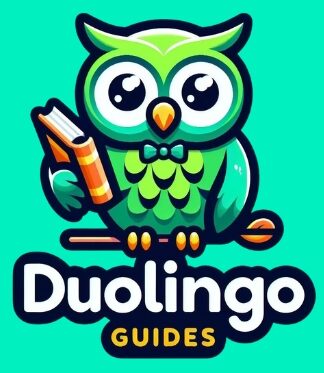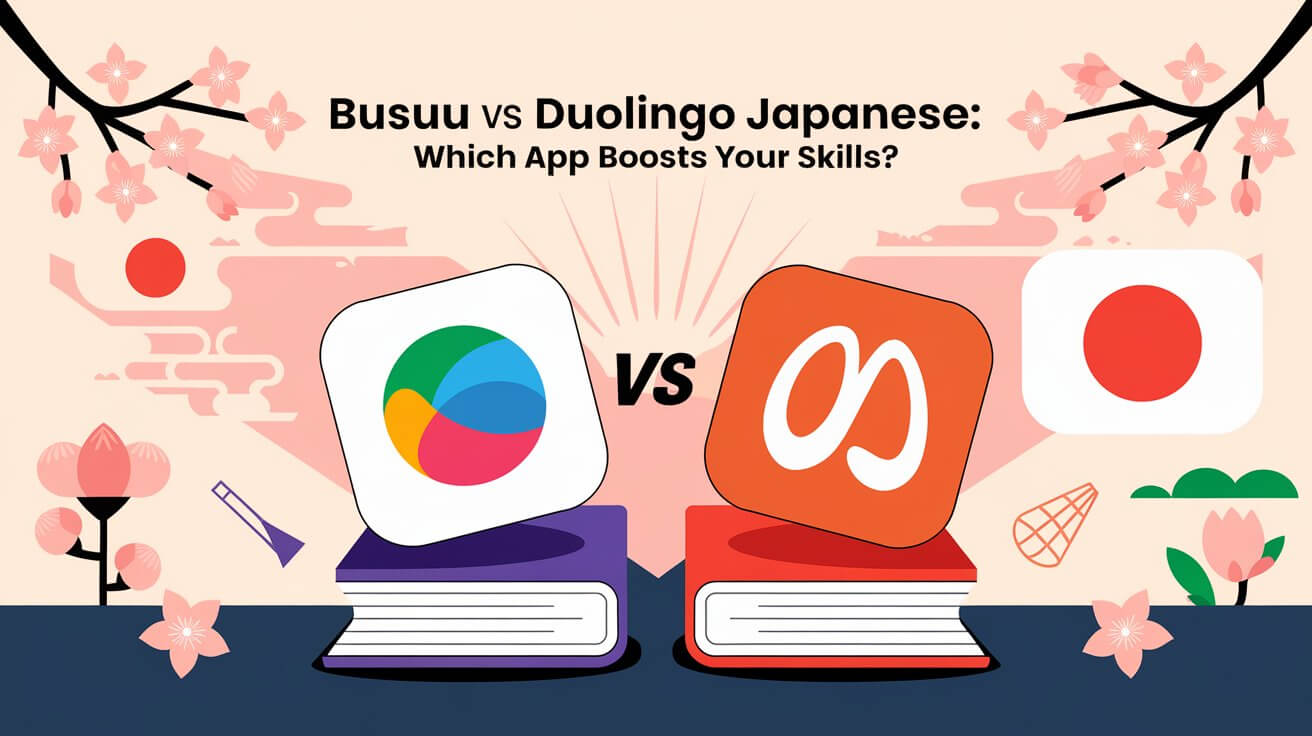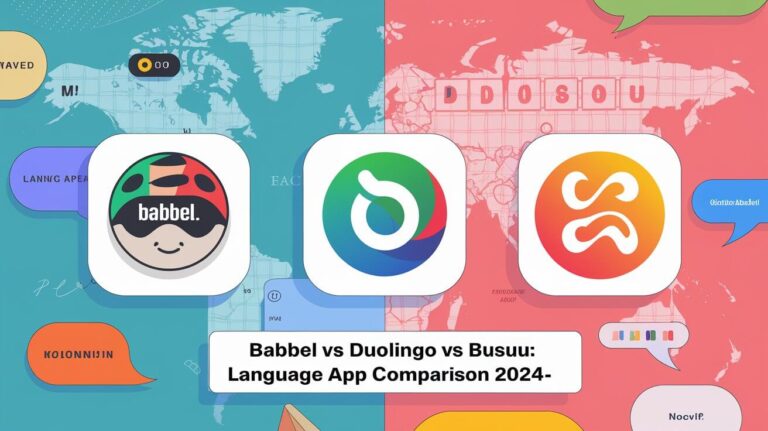Choosing the right app to learn Japanese can make a big difference. Busuu and Duolingo are two top picks, but they teach in different ways. Each has its own style and tools to help you learn. This guide breaks down how Busuu and Duolingo stack up for Japanese learners, so you can pick the one that fits you best.
Overview of Busuu and Duolingo
What is Busuu?
Busuu is a language learning platform that offers courses in several languages, including Japanese. It uses a mix of self-paced lessons and community interaction to help users learn. The app’s name comes from a nearly extinct language in Cameroon, highlighting Busuu’s mission to preserve and promote language learning.
What is Duolingo?
Duolingo is a free language learning app known for its gamified approach. It offers courses in many languages, with Japanese being one of its popular options. The app uses short, bite-sized lessons and a streak system to keep users engaged and learning consistently.
Japanese Learning Approaches
Busuu’s Method for Teaching Japanese
Busuu takes a structured approach to teaching Japanese. It divides its course into CEFR levels, from A1 (beginner) to B2 (upper intermediate). Each level contains various units focusing on different themes and language skills.
Duolingo’s Japanese Learning Strategy
Duolingo uses a tree-like structure for its Japanese course. Users progress through different skills, unlocking new lessons as they go. The app emphasizes repetition and gamification to help learners retain information.
Course Structure and Content
Busuu Japanese Curriculum
Busuu’s Japanese course covers a wide range of topics, from basic greetings to more complex conversations. Each lesson typically includes:
- Vocabulary introduction
- Grammar explanations
- Reading and listening exercises
- Speaking and writing practice
Duolingo Japanese Lessons
Duolingo’s Japanese course is organized into skills like:
- Hiragana
- Basic phrases
- Food
- Family
- Travel
Each skill contains multiple lessons, and users must complete previous skills to unlock new ones.
Grammar Instruction
How Busuu Teaches Japanese Grammar
Busuu provides detailed grammar explanations within its lessons. It often uses example sentences and interactive exercises to help users understand and practice grammatical concepts.
Duolingo’s Approach to Japanese Grammar
Duolingo takes a more implicit approach to grammar. While it does offer some explanations, users are expected to infer many grammar rules through exposure and practice.
Vocabulary Building
Busuu’s Vocabulary Lessons
Busuu introduces new vocabulary in context, often using images and audio. It also provides a review feature to help users remember words they’ve learned.
Duolingo’s Vocabulary Practice
Duolingo introduces vocabulary through its lessons and uses spaced repetition to help users retain words. It also has a separate vocabulary practice feature.
Kanji and Writing Systems
Busuu’s Kanji Teaching Method
Busuu introduces kanji gradually throughout its course. It provides stroke order diagrams and practice exercises for writing kanji.
Duolingo’s Approach to Japanese Writing
Duolingo starts with hiragana and katakana before introducing kanji. It uses multiple-choice questions and typing exercises to help users recognize and remember characters.
Speaking and Pronunciation
Busuu’s Speaking Exercises
Busuu offers speaking exercises where users can record themselves and get feedback from native speakers. This feature sets it apart from many other language apps.
Duolingo’s Pronunciation Practice
Duolingo includes speaking exercises where users repeat words or phrases. It uses speech recognition technology to check pronunciation.
Listening Comprehension
Busuu’s Listening Activities
Busuu incorporates listening exercises throughout its lessons. These often include dialogues or short stories, helping users get used to natural Japanese speech.
Duolingo’s Audio Lessons
Duolingo includes audio in most of its exercises. It also offers podcast-style lessons for some languages, though this feature isn’t available for Japanese at the time of writing.
User Interface and Experience
Navigating Busuu’s Platform
Busuu has a clean, professional interface. Its layout is intuitive, making it easy for users to find lessons and track their progress.
Duolingo’s App Design
Duolingo’s interface is colorful and game-like. Its design is simple and user-friendly, with clear icons and progress indicators.
Gamification and Motivation
Busuu’s Reward System
While less game-like than Duolingo, Busuu does use some gamification elements. Users can earn badges for completing lessons and reaching milestones.
Duolingo’s Gamification Features
Duolingo leans heavily into gamification. It uses:
- Experience points (XP)
- Levels
- Streaks
- Leaderboards
These features aim to keep users motivated and engaged.
Progress Tracking
Measuring Growth on Busuu
Busuu provides a clear overview of course progress. Users can see which lessons they’ve completed and their estimated CEFR level.
Duolingo’s Progress Indicators
Duolingo shows progress through its skill tree. Users can see their overall course progress and individual skill levels.
Community and Social Features
Busuu’s Language Exchange
One of Busuu’s standout features is its language exchange community. Users can submit writing or speaking exercises for native speakers to correct.
Duolingo’s Social Elements
Duolingo allows users to follow friends and compete on leaderboards. It also has a forum where learners can discuss language topics.
Pricing and Plans
Busuu’s Subscription Options
Busuu offers a free version with limited features. Its premium plans include:
- Premium: Full access to one language
- Premium Plus: Access to all languages and offline mode
Duolingo’s Free and Premium Versions
Duolingo is primarily free, with ads. Its premium version, Duolingo Plus, offers:
- Ad-free experience
- Offline access
- Unlimited hearts (attempts)
Effectiveness for Different Learner Levels
Busuu for Beginners vs Advanced Learners
Busuu caters well to beginners and intermediate learners. Its structured approach and CEFR alignment make it suitable for those aiming for recognized proficiency levels.
Duolingo’s Suitability Across Proficiency Levels
Duolingo is most effective for beginners. While it does offer more advanced content, it may not be comprehensive enough for upper-intermediate or advanced learners.
Additional Resources and Features
Busuu’s Supplementary Materials
Busuu offers:
- Printable PDF lessons
- Vocabulary flashcards
- Grammar tips
Duolingo’s Extra Learning Tools
Duolingo provides:
- Stories (not available for Japanese yet)
- Duolingo Events (online meetups)
- Tinycards (flashcard app)
Mobile vs Desktop Experience
Busuu on Different Devices
Busuu offers a consistent experience across mobile and desktop platforms. All features are available on both.
Duolingo’s Cross-Platform Functionality
Duolingo is primarily designed for mobile but offers a web version. Some features may be limited on the web version.
User Reviews and Feedback
What Learners Say About Busuu Japanese
Many users praise Busuu for its structured approach and community features. Some find the premium version expensive but worth it for serious learners.
Duolingo Japanese User Experiences
Duolingo users often appreciate its fun, gamified approach. However, some feel it doesn’t provide enough depth for serious Japanese study.
Pros and Cons
Advantages and Drawbacks of Busuu
Pros:
- Structured, CEFR-aligned course
- Community feedback on speaking and writing
- Detailed grammar explanations
Cons:
- Limited free version
- Can be expensive for long-term use
- Fewer gamification elements
Strengths and Weaknesses of Duolingo
Pros:
- Free and accessible
- Highly engaging gamification
- Consistent practice through short lessons
Cons:
- Less structured approach
- Limited grammar explanations
- May not be sufficient for advanced learners
Final Thoughts
Both Busuu and Duolingo have good points for learning Japanese. Busuu is more like a traditional class, with detailed lessons and community help. Duolingo is easier to use and more fun, making it great for beginners or quick practice.
Choose based on how you like to learn, what you want to achieve, and your budget. Some people use both apps together. Busuu helps with structured learning and writing, while Duolingo is good for daily word practice and listening.
Remember, apps alone won’t make you fluent in Japanese. Use them with other tools like books, Japanese media, and talking with native speakers for the best results.







